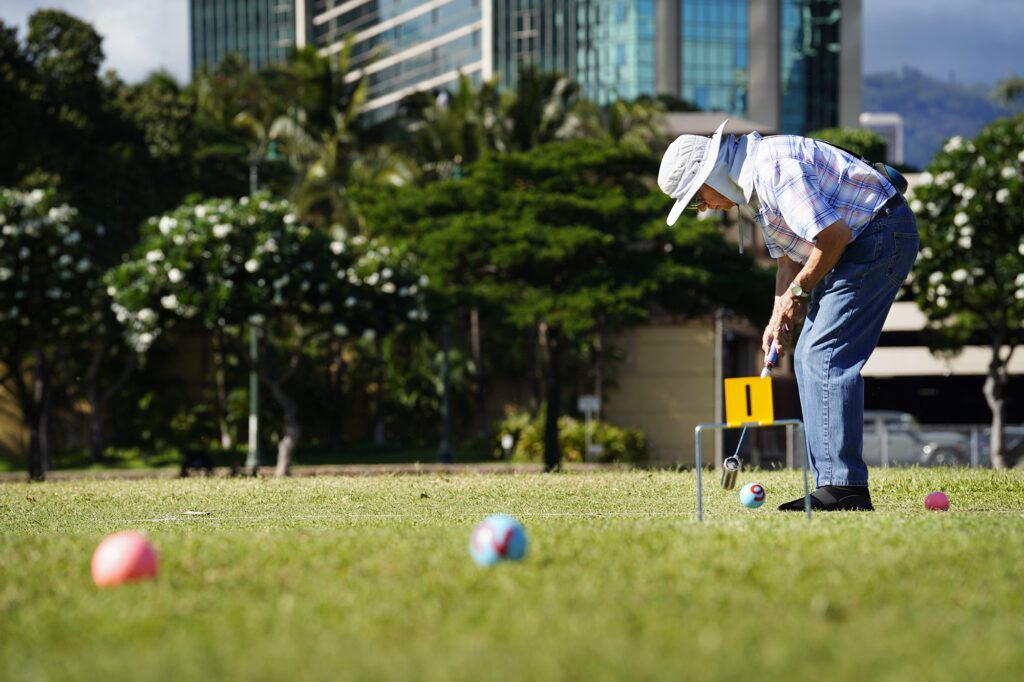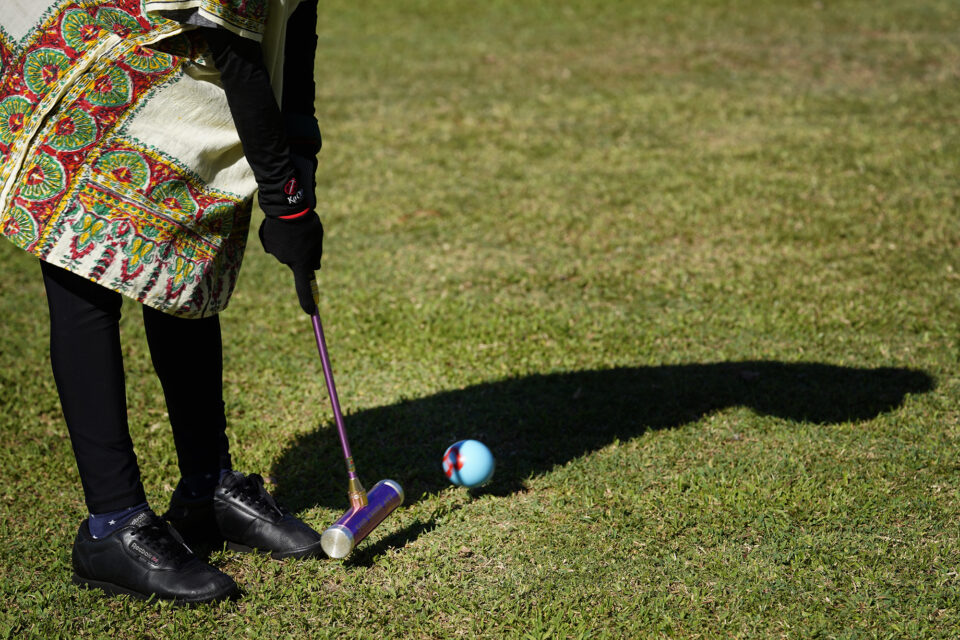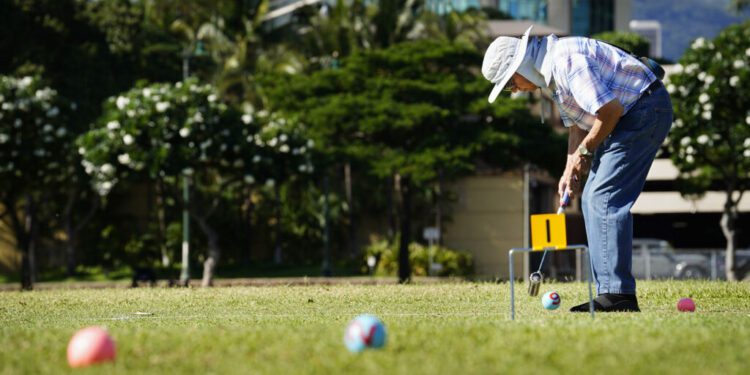Every Sunday, just after sunrise, a group of seniors gathers at Ala Moana Regional Park. They mow a rectangular patch of grass about the size of a Little League baseball field, place three ankle-height “gates” and a pole on the trimmed land — and just like that are ready to play on a freshly made gateball court.
The small team of Japanese American kupuna are some of the last remaining players in Hawaii of a sport that was once so widespread in the islands that Honolulu was selected as the site of the World Gateball Championship in 1998.
While the sport is still incredibly popular in many parts of Asia, most remaining players in Hawaii have largely lost contact with others outside of their own teams, and the once-active network of players has shriveled.
Veteran educator Art Kimura is one of the newer players at Ala Moana, but he’s on a mission to revive gateball in Hawaii as a way to improve physical and mental health among the state’s rapidly growing population of seniors.

 Gateball player Steven Kaneshiro strikes a ball toward the first gate during practice at Ala Moana Regional Park. Kaneshiro discovered the sport after reconnecting with Art Kimura, who was one of his high school teachers. (Kevin Fujii/Civil Beat/2024)
Gateball player Steven Kaneshiro strikes a ball toward the first gate during practice at Ala Moana Regional Park. Kaneshiro discovered the sport after reconnecting with Art Kimura, who was one of his high school teachers. (Kevin Fujii/Civil Beat/2024)
Kimura’s interest in the Japanese sport was sparked during a trip in March to an area of Okinawa that’s been designated a blue zone — a term researchers use for parts of the world where people live exceptionally long and healthy lives.
“When we asked the elders there, ‘Why do you live so long,” they wouldn’t answer the question, because to them everything they do is a lifestyle,” Kimura said. “But one answer they gave us consistently was ‘gateball.’”
Having played for three months now, he understands gateball’s appeal to the Okinawan elders he spoke to: light physical exercise, socialization as a team sport, and plenty of opportunities to use mental energy.
Today, Kimura wants to restore Hawaii’s lost connection with the Japanese sport by establishing a solid intergenerational base of players.
Kimura, a former high school teacher and public school administrator who garnered national recognition after helping popularize scholastic robotics competitions in Hawaii, is starting by contacting local schools and teachers throughout Oahu to promote gateball as a sport for students.
“I would love to see this start in schools so that children can play with their grandparents,” Kimura said.
Gerontology experts who support Kimura’s efforts say creating a strong intergenerational bond within families through gateball could help address social isolation – a health risk that can lead to serious consequences such as dementia and premature death, according to the Centers for Disease Control and Prevention.
A Forgotten Game
Invented in 1947 by Suzuki Kazunobu in Japan, gateball was originally devised for children who lacked adequate play equipment in the postwar era. A shortage of rubber inspired Suzuki Kazunobu, who worked in the lumber industry, to make sports gear with wood and revise the rules of croquet for a younger audience.

 Local newspaper articles from the mid-1980s show how gateball gained traction in Hawaii. (Screenshot/Newspapers.com)
Local newspaper articles from the mid-1980s show how gateball gained traction in Hawaii. (Screenshot/Newspapers.com)
The sport was introduced to Hawaii in the early 1980s by first-generation Japanese immigrants. A prominent figure lauded as the father of gateball in Hawaii was Satoshi Migita, who according to his obituary was awarded a Japanese order — a medal honoring people for their achievements and service to Japan — for popularizing the sport in Hawaii and championing the network between Hawaii and Japan.
Gateball is still played by millions of people internationally and is particularly prevalent in East Asian nations like Japan and China, according to the Japan Gateball Union.
This sport is usually enjoyed by seniors and played five-on-five. During the 20- to 30-minute game, each player attempts to pass the ball through the small “gates” using a mallet-shaped stick in sequential order to gain points, similar to croquet. The center goal pole serves as an opportunity to score two points, the game’s grand finale that players refer to as “agari.” A pre-recorded voice times the game through a portable speaker.
The group in Ala Moana is known as Glenn Kitamura’s Team. Kitamura brings the equipment – sticks, balls, field marking tape, and gates – and other players bring small snacks to share in between games.
The oldest player on Kitamura’s team, 91-year-old Norman Miyamoto, vividly remembers the seventh World Gateball Championship held at Ala Moana Regional Park in 1998. He played in the championship along with 1,300 players from a dozen different countries.
“We had about five or six local teams from Hawaii,” Miyamoto said.
At the time, Miyamoto said, local players were part of an active network with players from countries in East Asia. Players from different countries traveled to the islands for months during the winter to keep their hand in the sport, he said, just as a golf aficionado might.

 (Screenshot/Newspapers.com)
(Screenshot/Newspapers.com)
Miyamoto believes that the sport was not successfully passed on to another generation of players, in part because it is perceived as a game for seniors.
“When the old players started to retire, quit, or die, we didn’t get new players coming in,” Miyamoto said. “So that’s why there are no new players.”
This was the case for Kimura as well. Although he knew that his grandfather had played gateball, he and other family members from his generation were not introduced to this sport.
Active Aging
On the verge of turning 80, Kimura is actively working to bring gateball back to life in the islands by promoting it to seniors and schools as well.
He believes that gateball would be a great sport for keiki and kupuna alike, because it does not require the athleticism that many other sports demand. It also calls for the kind of strategic thinking that can help build mental fitness.

 Gateball player Noriko Narita strikes a ball during practice at Ala Moana Regional Park in Honolulu. Gateball resembles croquet but requires a different strategy. (Kevin Fujii/Civil Beat/2024)
Gateball player Noriko Narita strikes a ball during practice at Ala Moana Regional Park in Honolulu. Gateball resembles croquet but requires a different strategy. (Kevin Fujii/Civil Beat/2024)
“You can just set it up on your playground, and the initial cost is not high,” he added.
He also plans to reach out to organizations that offer programs for children and seniors such as the YMCA and senior centers.
Kevin Kawamoto, a gerontological social work educator at the Center on Aging at the University of Hawaii Manoa, said that he supports sports that get seniors out and about and that gateball can be a great sport to encourage this cause.
“Something like that will hit all of those three types of aging — biological, psychological, and social — all at once,” Kawamoto said. “Find what you love, do it with other people that you enjoy being around, and do it on a regular basis. That is active aging.”
Active aging refers to the notion of retired seniors actively engaging in social activities to find a solution for the “what next?” question as they live the last decades of their life.
Cullen Hayashida, gerontology expert and founding director of the Kupuna Education Center at Kapiolani Community College, is at the forefront of active aging initiatives in Hawaii. He stresses the need for the community to find new ways to promote active aging as seniors live longer.
“The goal is to live long and die short; you don’t want to live long and die long,” Hayashida said. “If we are productive right up until the very end, continuously contributing, helping, and connecting with others, that’s a good thing from a gerontological perspective.”

Sign up for our FREE morning newsletter and face each day more informed.
Sign Up
Sorry. That’s an invalid e-mail.
Thanks! We’ll send you a confirmation e-mail shortly.
Source link : http://www.bing.com/news/apiclick.aspx?ref=FexRss&aid=&tid=66db04d6f2ec485dab1e13a2d8d84e0b&url=https%3A%2F%2Fwww.civilbeat.org%2F2024%2F09%2Fthese-hawaii-seniors-say-a-japanese-sport-holds-the-key-to-a-healthier-and-happier-life%2F&c=7656771249919113359&mkt=en-us
Author :
Publish date : 2024-09-05 23:01:00
Copyright for syndicated content belongs to the linked Source.





